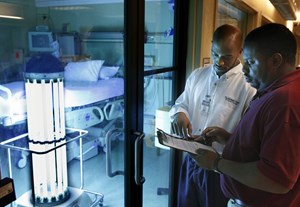Nov 10 2014
Reports have shown that hospital-acquired infections (HAIs) are costing hospitals more than $33 billion annually. Additionally, on average one in 25 patients acquires an HAI while being treated. As a result, many hospital leaders are looking for tools, such as TRU-D SmartUVC, that promote patient safety and ensure high reimbursement payments – keeping both their patient population and their operating budgets as healthy as possible.
 Staff at the Medical Center of Central Georgia utilize multiple TRU-D's to thoroughly disinfect their hospital.
Staff at the Medical Center of Central Georgia utilize multiple TRU-D's to thoroughly disinfect their hospital.
TRU-D, which works by generating UV light energy that modifies the DNA or RNA structure of an infectious cell, is the only portable UV disinfection system on the market with Sensor360 technology. The device's patented technology automatically calculates the time needed to react to room variables – such as size, geometry, surface reflectivity, and the amount and location of equipment in the room – and delivers a lethal dose from a single location in the room, effectively eliminating lingering pathogens in the entire room, including shadowed spaces. This technology coupled with TRU-D's high-efficiency germicidal lamps kills deadly germs such as Ebola, methicillin-resistant staphylococcus aureus (MRSA), Clostridium difficile (C. diff.), Middle East Respiratory Syndrome (MERS), Norovirus and Enterovirus D68.
Hundreds of hospitals are taking prevention seriously by deploying multiple TRU-D robots throughout the hospital or health care system. One such hospital is the Medical Center, Navicent Health (formerly The Medical Center of Central Georgia), which has deployed five TRU-D units since 2010, circulating three among patient rooms and two among operating rooms. Hospital officials attribute the deployment of TRU-D technology, along with evidence-based practices, to a significant decrease in organisms, or germs, that cause infections and infectious disease.
"We attribute the reduction in hospital-acquired infections to evidence-based or scientifically-proven practices," said Nancy Osborn, RN, CIC, manager of infection prevention and epidemiology for the Medical Center, Navicent Health. "High on the list of interventions at the Medical Center, Navicent Health is the judicious use of TRU-D in patient rooms as well as a nightly rotation in the surgical suites. We want our patient environment to be as clean as possible, and TRU-D allows us to accomplish that goal. Our patients can be assured that our rooms are free of the environmental pathogens that pose an infection risk. Thanks to TRU-D technology, our hospital has experienced a reduction in some of the most contagious germs, such as spore-forming organisms that challenge hospitals throughout the world. With five units, we are constantly prepared for room disinfection."
TRU-D, which has been validated by 10 independent studies and proven to kill 99.99 percent of pathogens, is quick and easy to set up and does not require input of room measurements or covering of windows and vents. TRU-D spends the time necessary to deliver a guaranteed dose of germ-eliminating UV light energy, something no other device on the market can do.
"Hospital decision makers must be diligent in selecting UV disinfection technology, as it is well known that pulsed light systems adapted from UV-curing lamps and other low cost systems that do not measure dose are inefficient in delivering a germicidal dose, resulting in inconsistent outcomes," says Chuck Dunn, chief executive officer of TRU-D SmartUVC. "Only TRU-D can deliver a measured dose and a consistent baseline of thorough disinfection, consistency being the cornerstone of quality of care and patient safety."
"When combined with appropriate hand hygiene and contact precautions, TRU-D has proven effective in making the Medical Center, Navicent Health safer for patients and ensuring that we provide the highest level of patient care possible," said Dr. Fady Wanna, chief medical officer and chief clinical officer for Navicent Health.
TRU-D SmartUVC is the device of choice for nearly all of the existing independent research on UV disinfection technology. Hundreds of TRU-Ds have been deployed to disinfect hospitals across the U.S., Canada, Europe and Africa, including the National Institutes of Health Clinical Center in Bethesda, Maryland; the Ralph H. Johnson VA Medical Center in Charleston, South Carolina; and Houston Methodist in Houston, Texas. For information and links to independent studies on TRU-D, visit www.TRU-D.com.
Navicent Health was incorporated on November 17, 1994, as a nonprofit corporation whose primary purpose is to coordinate the Medical Center, Navicent Health and other affiliated entities in their mission of providing a comprehensive continuum of high quality, reasonably priced healthcare services to the region. Navicent Health has 830 beds for medical, surgical, rehabilitation and hospice purposes. The health system includes Medical Center, Navicent Health, a nationally recognized tertiary teaching hospital; Children's Hospital, Navicent Health, the region's only dedicated pediatric hospital; Medical Center of Peach County, Navicent Health, a rural critical access hospital; Rehabilitation Hospital, Navicent Health, the region's oldest and most experienced rehabilitation provider; Pine Pointe Hospice, Navicent Health, which provides palliative and hospice care in homes and in its facility; Carlyle Place, Navicent Health, the area's first continuing care retirement community; Medcen Community Health Foundation, Navicent Health, the philanthropic arm of Navicent Health; as well as diagnostic and home care services.